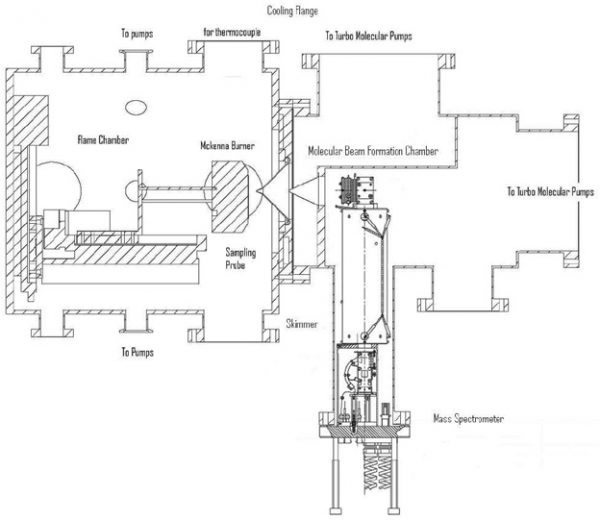Molecular Beam Mass Spectrometry
Flat flame MBMS technique has been proven to be a very powerful tool to study combustion chemistry of hydrocarbon fuels by providing one-dimensional concentration profiles of radicals and stable species. Flat premixed laminar flames offer the advantage of radial uniformity of flow field, gas concentrations, and temperature profiles such that the flame can be simplified as one-dimensional problem in the axial direction. In the low-pressure conditions, flame thickness is greatly enlarged relative to higher pressure, favoring spatially-resolved measurement on temperature and concentration profiles. In the MBMS sampling technique, the center part of the flame gases are expanded into a much lower-pressure chamber through a quartz probe with a small orifice leading to the formation of molecular beam. The chemical reactions are rapidly shutdown due to the collisionless nature of the molecular beam, and consequently, most of the radicals and stable species are able to persist their flame concentrations. Mass spectrometer is used to selectively ionize, identify and quantify the combustion gas species by their masses, peak intensity and ionization cross sections. The mole fractions of fuel and oxidizer, combustion intermediates and final products can be mapped out across the flames by varying the axial distance between the tip of sampling probe and burner surface, providing a complete test of the underlying chemical mechanism over a wide temperature range. In this group, we are dedicated into the combustion chemistry of important diesel and jet fuels surrogates, particularly in soot formation mechanism. By collecting the data from experiments in NCSU and ALS, and comparing them against numerical simulations based on the detailed chemical kinetics of elementary reactions sets, we are exploring the fundamental understanding of fuel destruction, intermediates formation and consumption, and final products generation mechanism. These work will potentially lead to pollution reduction and energy efficiency in various combustion environments.
(Note: the various flat flames seen on the left column throughout this website are from MBMS systems.)

